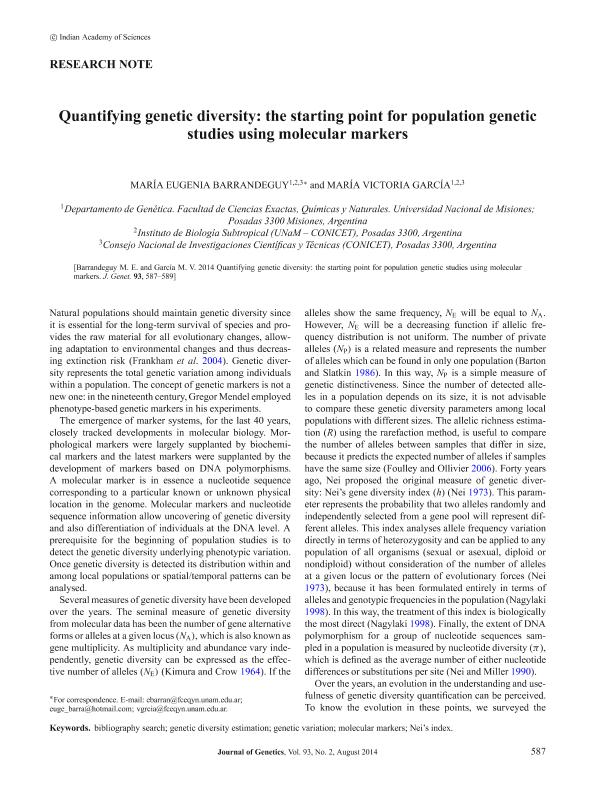Mostrar el registro sencillo del ítem
dc.contributor.author
Barrandeguy, Maria Eugenia

dc.contributor.author
García, María Victoria

dc.date.available
2018-02-20T16:21:27Z
dc.date.issued
2014-10
dc.identifier.citation
Barrandeguy, Maria Eugenia; García, María Victoria; Quantifying genetic diversity: the starting point for population genetic studies using molecular markers; Indian Academy of Sciences; Journal of Genetics; 93; 2; 10-2014; 587-589
dc.identifier.issn
0022-1333
dc.identifier.uri
http://hdl.handle.net/11336/36808
dc.description.abstract
Natural populations must keep genetic diversity since it is essential for the long-term survival of species and provides the raw material for all evolutionary changes.The emergence of marker systems has, for the last 40 years, closely tracked developments in biochemistry and molecular biology. Morphological markers were largely supplanted by biochemical markers and the latest markers were supplanted by the development of markers based on DNA polymorphisms. A molecular marker is in essence a nucleotide sequence corresponding to a particular known or unknown physical location in the genome.Genetic diversity represents the total genetic variation among individuals within a population. Over the years an evolution in the understanding of genetic diversity quantification can be perceived. In order to know the evolution in this understanding we surveyed the archives of the prestigious scientific journal Heredity. Population genetics was born mainly as a theoretical science. Protein electrophoresis produced data that could be interpreted using the language and perspective of traditional population genetic theory and it allowed that population genetic become in an empirical science. The field of empirical population genetics started to be preoccupied with characterizing and quantifying genetic variation. Now this view is evolving and the impact of population genetics increased considerably in almost all fields of biology. We could conclude that estimation of genetic diversity was the goal of several studies per se twenty years ago. However, quantification of genetic diversity is nowadays an obligatory step in population genetic studies regardless of the main aim of these studies.
dc.format
application/pdf
dc.language.iso
eng
dc.publisher
Indian Academy of Sciences

dc.rights
info:eu-repo/semantics/openAccess
dc.rights.uri
https://creativecommons.org/licenses/by-nc-sa/2.5/ar/
dc.subject
Bibliography Search
dc.subject
Genetic Diversity Estimation
dc.subject
Genetic Variation
dc.subject
Molecular Markers
dc.subject
Neis Index
dc.subject.classification
Otras Ciencias Biológicas

dc.subject.classification
Ciencias Biológicas

dc.subject.classification
CIENCIAS NATURALES Y EXACTAS

dc.title
Quantifying genetic diversity: the starting point for population genetic studies using molecular markers
dc.type
info:eu-repo/semantics/article
dc.type
info:ar-repo/semantics/artículo
dc.type
info:eu-repo/semantics/publishedVersion
dc.date.updated
2016-12-26T18:45:57Z
dc.journal.volume
93
dc.journal.number
2
dc.journal.pagination
587-589
dc.journal.pais
India

dc.journal.ciudad
Bangalore
dc.description.fil
Fil: Barrandeguy, Maria Eugenia. Consejo Nacional de Investigaciones Científicas y Técnicas. Centro Científico Tecnológico Conicet - Nordeste. Instituto de Biología Subtropical. Universidad Nacional de Misiones. Instituto de Biología Subtropical; Argentina
dc.description.fil
Fil: García, María Victoria. Consejo Nacional de Investigaciones Científicas y Técnicas. Centro Científico Tecnológico Conicet - Nordeste. Instituto de Biología Subtropical. Universidad Nacional de Misiones. Instituto de Biología Subtropical; Argentina
dc.journal.title
Journal of Genetics

dc.relation.alternativeid
info:eu-repo/semantics/altIdentifier/doi/https://doi.org/10.1007/s12041-014-0407-7
dc.relation.alternativeid
info:eu-repo/semantics/altIdentifier/url/http://www.ias.ac.in/listing/articles/jgen/093/02
dc.relation.alternativeid
info:eu-repo/semantics/altIdentifier/url/http://www.ias.ac.in/article/fulltext/jgen/093/02/0587-0589
Archivos asociados
